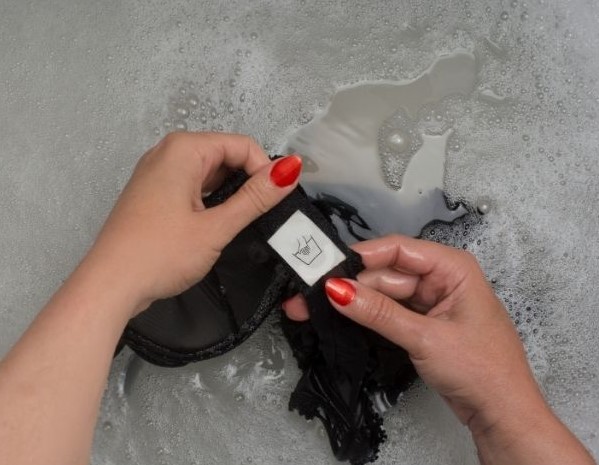Lingerie Care Guide

Whether it's your fave lace plunge or your go-to t-shirt bra, you'll want your underwear to look good and support you for as long as possible. After all, you've spent both your valuable time (looking for the perfect fit) and your hard-earned money on them. Despite this, most of us simply put our most beautiful underwear into the washing machine, hit the start button, and pray for the best. We may not only be hurting our valuable garments, but we may also be harming the environment.
1. Bras
How often should you wash your bra?
Over-washing might harm the flexibility, which is necessary for adequate support. This is true even if you wash your bra by hand as instructed. Wringing too hard might bend the wires, erode the wire casing, and even cause the wire to protrude through, potentially harming your boobs. So how often should you wash your bra? that all depends on what you’ve done while you’re wearing it. When it comes to normal use, every two to three wears is fine. Obviously, that’s not the case if it’s a sports bra you’re wearing to an intense gym class or if it’s a hot summer’s day. If you’re particularly sweaty, you should wash the bra each wear.
Do you really need to hand wash your bras?
If you refuse to buy garments that require handwashing, the thought of getting your fingers wet only to wash a bra may make you cringe.
If a certain balconette or sweetie means a lot to you, you'll want it to last as long as possible. Handwashing is the only foolproof method and the finest technique to clean bras. It is also a more environmentally responsible way to wash your clothes because it uses less washing liquid while using less water. As a result, needless packaging and the number of chemicals discharged into the environment are reduced.
We strongly advise you to hand-wash all of your underwear and swimwear to maintain the original fit and support for much longer. But it's especially important to hand-wash any garments with wires since not only will you shorten the life of the bra if you don't, but you could also harm the washing machine if the wire falls out. Are you still not convinced? Here are some additional compelling reasons to roll up your sleeves and get soapy...
- Excessive washing at high temperatures or on a non-delicate cycle might stretch the elastic fibers over time, reducing the life of your bra.
- Hooks might become entangled towards the back of the drum, bending, or breaking.
- Straps can become entangled in other clothing, causing them to overstretch.
- It's better for the environment!
How To Wash Bras By Hand
 Handwashing is commonly regarded as a laborious chore that places significant strain on the forearms. Hand-washing your bra, on the other hand, is different - and can be even faster than using a machine. No, seriously!
Handwashing is commonly regarded as a laborious chore that places significant strain on the forearms. Hand-washing your bra, on the other hand, is different - and can be even faster than using a machine. No, seriously!
Simply fill a washbasin with cold water. Pour in some liquid lingerie detergent or another light detergent. Put your filthy bras in the water (preferably with the clasps fastened so they don't snag anyplace they shouldn't) and swirl them around. Soak for 10 minutes, then gently rub all over, paying special attention to the underarms and back band. Rinse in cool, clean water, then gently squeeze to remove excess water (no twisting or wringing as this might harm the elastic).
Roll the bra up on a clean, dry towel to absorb even more moisture. The bra should then be reshaped before drying (more on that later).
Washing Bras in a Washing Machine
We've told you everything, yet you still refuse to hand-wash your bra? You are a rebel. If you absolutely must, use the most gentle wash available at the lowest feasible temperature and, preferably, without spinning. To avoid snagging, tighten the clasps and store your bra in a mesh lingerie bag (or, at a pinch, a pillowcase). You can put multiple items in the bra wash bag, but don't overfill it or they won't get clean. Place the delicates wash bag in the washing machine with a few towels or other items to help balance the load. Any fabric conditioner should be avoided at this time because it will soften the elastic and cause it to stretch. That is why you should avoid using fabric conditioner while washing swimwear or lycra pants.
How Do You Dry A Bra
Never, ever, ever tumble dry. Heat can damage delicate clothing by misshaping the bra, straining the elastic, and even melting the wire. Not to mention how much energy it consumes! So, what should we do in its place? Always hang it to dry on the line (or hang it on a coat hanger) from the bridge in the centre front between the cups.
Don’t hang by the straps as the wet bra hanging down will stretch them.
Removing Creases From Your Bra Padding
Dimples are adorable, but not when they're embedded in your bra padding. When it comes to creases in the cup, a little heat is required. If wrinkles appear on your T-shirt bra, use your iron to blast them away.
Hold the iron about three inches away from the fabric, being cautious not to burn your fingers or touch it with the iron.
How To Care For Your Bra
Don't just tuck them away in your lingerie drawer and hope for the best. Normal underwired bras can be folded through the centre front bridge (the portion between the cups) to keep the wires flat against each other, with the wings attached and folded behind the cups. Moulded bras, on the other hand, must be stored flat and unfolded to avoid creases in the padding.
2. Delicate Panties: How To Care For Them
Pristine white lace, lovely hues, and silky ribbons. We all want a drawer full of date-night appropriate knickers. So, why are so many of ours relegated to the once-a-month pile?
Handwashing particularly special items according to the directions for bras above is always recommended. Washing machines can grab any extra embellishments, such as lovely bows or diamantes, and ruin the elastic. Treat any stains with a specialised remover first, then soak them for an extended period of time.
How To Care For Day-to-Day Panties
Everyday knickers present a quandary. Often, the label directs that they be washed at 40°C, although hygiene experts believe that anything below 60°C will not destroy bacteria. So, what should a female do?
The only choice here is to use laundry sanitizer, and while Dettol is perhaps the most well-known brand, many supermarkets now carry their own brand. (Sanitizer is also useful for keeping bed linen and towels clean and bacteria-free while washing them.)
Tips For Panties Care
Because we wash panties more frequently than bras, they tend to wear out faster. If you want matching sets, it's always worth getting two or three pairs of underwear to go with every 'expensive' bra.
When it comes to keeping knickers, start by cleaning out your lingerie drawer. Get rid of everything that doesn't'spark delight' - we're looking at you, scratchy lace impulse purchase. Then, to give everything a home, use inexpensive drawer dividers.












